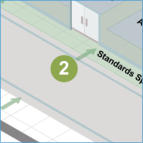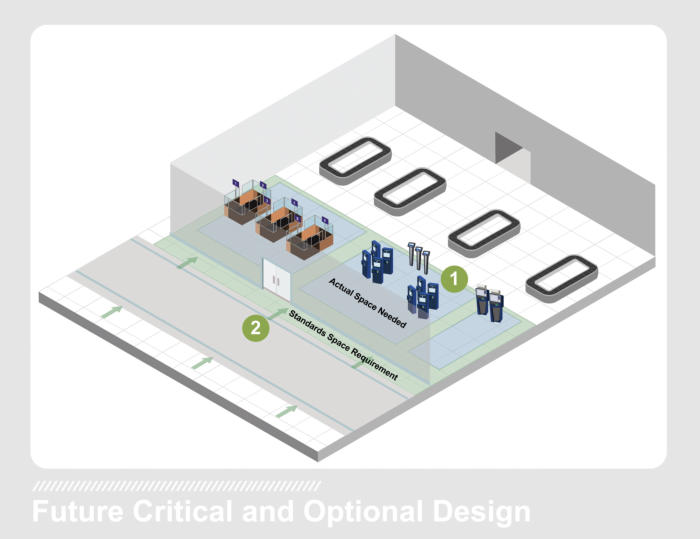

© National Safe Skies Alliance - Authored by InterVISTAS Consulting



CBP Airport Technical Design Standard

Finding 11: Reduce Baseline Space Requirements
Significant space savings in the Primary processing and queuing areas can be attained over traditional booths on a passengers processed per hour basis when implementing self-service, automated technology (i.e., APC, MPC, and Global Entry). The amount of space savings that is attainable is different at each airport based on the passenger profile, ability to use automated solutions, and peak hour volume of passengers. Based on our findings, the baseline (as defined in ATD-03 – Chapter 5) can be reduced 10-24% from the current value. That is, the reduction is from 13.2 square feet per passenger to about 11 square feet per passenger.
Airport Applicability
- Any passenger volume - Any airport type -All passenger typesReferences
ATDS (2012) - Section 2.7.4 states that the FIS must accommodate all arriving passengers and queues at peak times - Section 3.1 introduces the airport size specification ATDS (2016 - 90% Draft) - Section 2.7 states that the FIS size is determined by passengers arriving at peak hours plus the size of aircraft which arrive - Section 5.3 outlines the space matrix and calculations required for the FIS - Code ATD-01-03 in Chapter 5




© National Safe Skies Alliance
Authored by InterVISTAS Consulting

CBP Airport Technical Design Standard
Finding 11: Reduce Baseline
Space Requirements
A number of post-implementation analyses of self-service, automated technology (i.e. APC, MPC, Global Entry) have concluded that significant space savings in the primary processing and queuing areas can be attained over traditional booth on a passenger processed per hour basis. The amount of space savings that is attainable is different at each airport based on the passenger profile and ability to use automated solutions and peak hour volume of passengers. Based on our findings, the baseline (as defined in ATD- 03 – Chapter 5) can be reduced between 10-24% from the current value. That is, from 13.2 square feet per passenger to about 11 square feet. per passenger.
In order to calculate the actual queuing
space that is likely required, a full
analysis of the peak hour volume of
international passengers, profile of
passengers (i.e. percentages of Global
Entry members, U.S. citizens and
permanent residents, foreign nationals
who are exempt from visa, foreign
nationals requiring visa, etc.), and what
self-service automated solutions will be
implemented. Using queuing analysis
and/or multiple simulation model runs,
calculate the maximum queue sizes for
each border processing stream.
Applying a spatial level of service
against the number of passengers
queuing, the space that will be used can
be determined.
If the space actually needed for certain
areas of the FIS can be empirically
shown to be less than what is specified
in the ATDS, the airport can apply for an
exemption to the standards.
If the FIS does not need to be built to
full capacity from day one, there are
significant capital cost savings that can
be attained for the airport. If the
calculated amount of space needed is
equal to or greater to that stated in the
ATDS space requirements, the airport
should build the space accordingly and
continue with the usual facilities
approval.



































